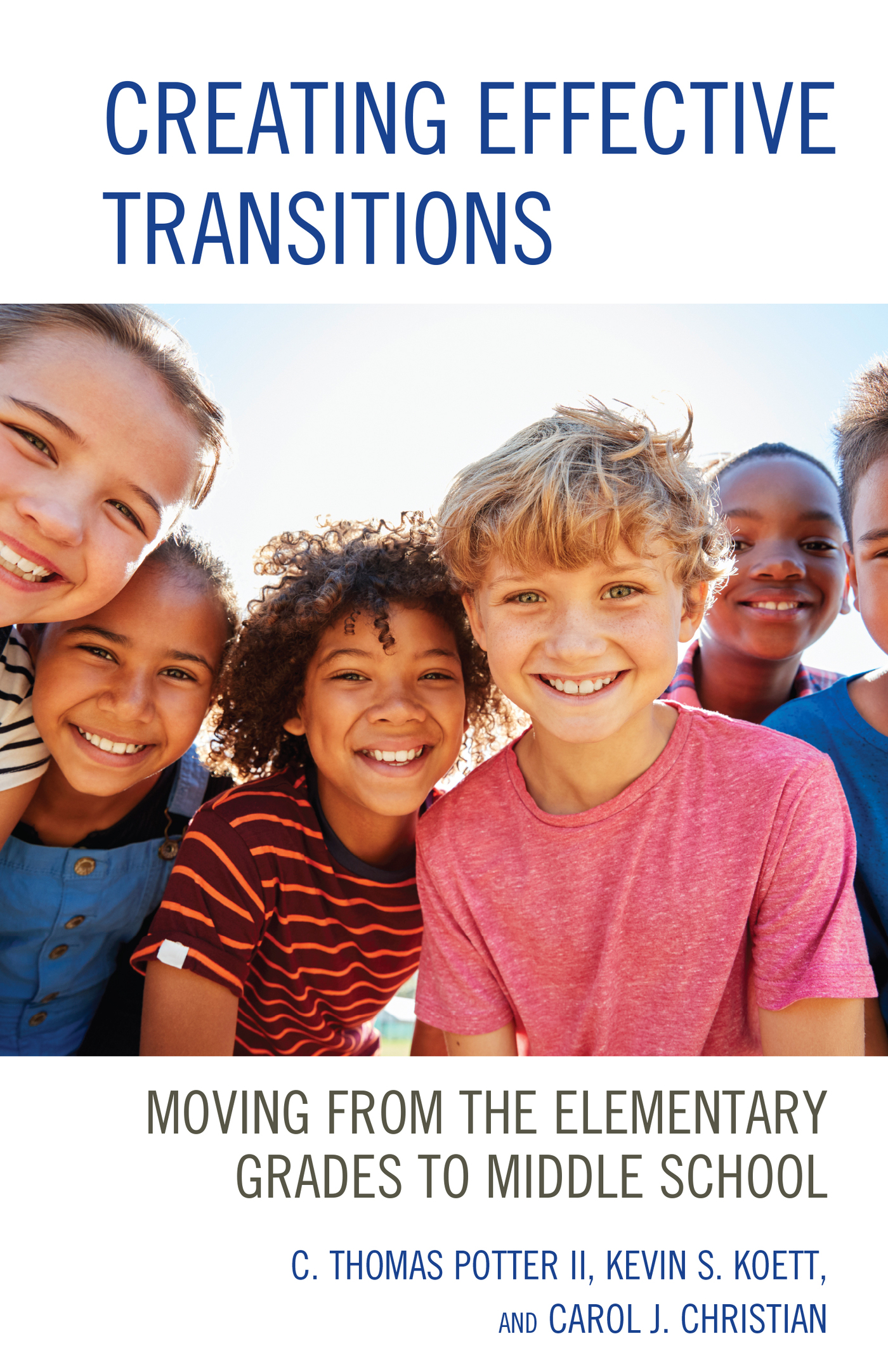Creating Effective
Transitions
Creating Effective
Transitions
Moving from the Elementary Grades to Middle School
C. Thomas Potter II, Kevin S. Koett, and Carol J. Christian
ROWMAN & LITTLEFIELD
Lanham Boulder New York London
Published by Rowman & Littlefield
An imprint of The Rowman & Littlefield Publishing Group, Inc.
4501 Forbes Boulevard, Suite 200, Lanham, Maryland 20706
www.rowman.com
Unit A, Whitacre Mews, 26-34 Stannary Street, London SE11 4AB
Copyright 2018 by C. Thomas Potter II, Kevin S. Koett, and Carol J. Christian.
All rights reserved. No part of this book may be reproduced in any form or by any electronic or mechanical means, including information storage and retrieval systems, without written permission from the publisher, except by a reviewer who may quote passages in a review.
British Library Cataloguing in Publication Information Available
Library of Congress Cataloging-in-Publication Data
Names: Potter, C. Thomas, author.
Title: Creating effective transitions : moving from the elementary grades to middle school / C. Thomas Potter II, Kevin S. Koett, and Carol J. Christian.
Description: Lanham : Rowman & Littlefield, [2018] | Includes bibliographical references.
Identifiers: LCCN 2017061856 (print) | LCCN 2018011159 (ebook) | ISBN 9781475842692 (Electronic) | ISBN 9781475842678 (cloth : alk. paper) | ISBN 9781475842685 (pbk. : alk. paper)
Subjects: LCSH: Promotion (School)--Case studies. | Elementary school graduates--Case studies. | Middle school students--Case studies.
Classification: LCC LB3063 (ebook) | LCC LB3063 .P67 2018 (print) | DDC 371.2/83--dc23
LC record available at https://lccn.loc.gov/2017061856
 TM The paper used in this publication meets the minimum requirements of American National Standard for Information Sciences Permanence of Paper for Printed Library Materials, ANSI/NISO Z39.48-1992.
TM The paper used in this publication meets the minimum requirements of American National Standard for Information Sciences Permanence of Paper for Printed Library Materials, ANSI/NISO Z39.48-1992.
Printed in the United States of America
Preface
As a former elementary school principal, when my fifth grader was entering middle school it became apparent on a personal level how little was done between the elementary and middle schools to prepare students for the transition.
Fearful, anxious, and ill prepared are words that describe an elementary school student leaving the safety of the single classroom with one teacher and entering the multiclassroom and multiteacher schedule at the middle school. Can I keep up? Will I be accepted? Will there be supports in place to help me if I begin to falter?
With each new building transition, as in the move from elementary to middle school, students often enter into a larger, more impersonal school setting. The cohesive and caring atmosphere that existed for elementary students, where teachers knew their students on a personal level, is often replaced by one in which students wander aimlessly in and out of classrooms and where communication among faculty is limited. It is here where students can become lost in the transition.
These young learnerswho once loved coming to school, learning new things, and being active participantsmay now elect to disengage and disconnect. The downward spiral begins here unless teachers and school leaders recognize the importance of developing transition activities that can help elementary students ease their fears in the move to the middle school.
The authors hope this book, written from the perspective of real-life stories of students experiences during the transition, will move educators to change their practices and intentionally implement activites to aid students in this transition.
Introduction
This book focuses primarily on elementary to middle school transitions. Creating Effective Transitions: Moving from the Elementary Grades to Middle School is one in a series of three separate but interrelated books that share scenarios about the journey through schooling and the obstacles students face in each transition.
Elementary students up to this point in education have, for the most part, moved each year from one self-contained classroom to another. They might even move just across the hall from one grade and classroom to the next. Students are acquainted with the building and likely see the same faces daily. Each year seems like business as usual. It is comfortable and safe, filled with the same routines, and everything seems familiar to them.
Middle school is often drastically different. Students have five- to seven-period schedules each day, with five to seven different teachers. The faces are never the same in each class. The building is often larger, with multiple floors and wings jutting out in all directions. Managing all of this change poses its challenges.
Too many middle school professionals adopt the attitude that it is time for these students moving to the middle school to grow up; they should no longer be babied. It is true that each transition involves a letting go of some things in the process of moving toward self-actualization and becoming a mature individual. But to go from a nurturing atmosphere to one with little to no lifelines or anchors can cause many once-successful students to sinkand fast. Transition activities are just that: activities that help students adjust to the many changes that are occurring developmentally and as a result of the move to a new school.
The purpose of this work is twofold: first, to help educators and parents understand the roles they play in meeting the basic developmental needs of individual students during times of transition; and second, to help school leaders understand how critically important it is for organizations to create structured transition processes that support the growth and development of students in order to better ensure student success before, during, and after transition.
Transition success does not happen by chance. Schools must intentionally develop activities that make transition an easier experience for students. As students navigate through the K12 and postsecondary schools, multiple transitions occur that include (but are not limited to) moving to different, unfamiliar school buildings and going from self-contained classrooms with one teacher to departmentalized schools with numerous teachers. Most building transitions require a move to a larger, more impersonal school environment. It is during these periods of transition that students can become lost in the shuffle as they move through multiple-period days, various teacher routines and expectations, more complex schedules, and increased academic rigor, all at a time of great growth and developmental change. Each of these transitions can pose barriers to student success.
Many students lack the support structures at school and at home that help ensure a seamless transition; they may become lost in transition. Often these students begin to experience failing grades and an increase in inappropriate behaviors. As a result of frustration, fear, and the inability to cope with the stress, many students are at increased risk of dropping out of school.
The research that served as the foundational structure for this book centers on transition research and Abraham Maslows understanding of human growth and development. The literature in support of this research serves to assist educators and parents in understanding why it is important to intervene with a purposeful set of transition plans and activities that are intentionally developed to help students during the move from elementary school to middle school.
Next page
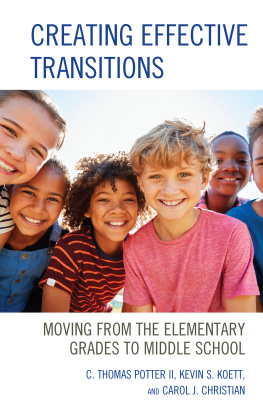



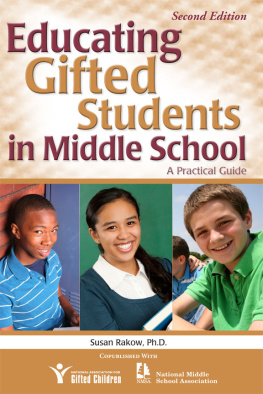
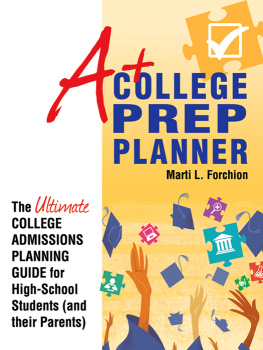
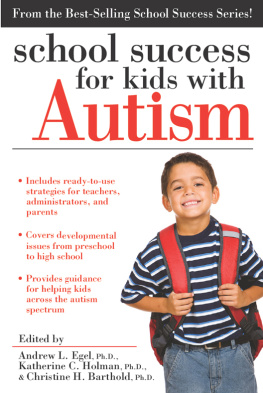

 TM The paper used in this publication meets the minimum requirements of American National Standard for Information Sciences Permanence of Paper for Printed Library Materials, ANSI/NISO Z39.48-1992.
TM The paper used in this publication meets the minimum requirements of American National Standard for Information Sciences Permanence of Paper for Printed Library Materials, ANSI/NISO Z39.48-1992.